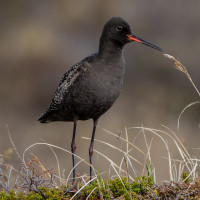Descrição
Vest Stadil Fjord consists basically of three shallow lakes surrounded by reedbeds and arable fields. The largest lake is Søndre Dyb, which is surrounded by reedbeds. All the way round this wet area are large areas where corn and grass are cultivated. The water quality in Søndre Dyb is poor due to heavy pollution from nitrates and ochre. Attempts are now being made to improve the situation through nature re-establishment in the northern part and more environmentally friendly farming.
Mellemdyb is where birds can generally best be seen. The area consists of several lakes surrounded by quite large reedbeds, which have, however, been removed at the car park next to Jens Bjerg-Thomsens hunting cabin on Skelmosevej – partly to give a better view and partly to keep the vegetation from spreading.
Nordre Dyb consists of several smallish lakes surrounded by reedbeds, grass fields and meadows. North of the re-established area, two basins have been dug out to enable ochre fall-out. Attempts are being made to re-establish wet meadows on the low-lying fields nearby with the help of flooding and grazing. The whole area around Vest Stadil Fjord is bordered on the west by a line of dunes and on the east by an embankment. It is an important staging area for large flocks of geese and ducks, and is a breeding site for many waterbirds. Large flocks of Ganso-de-faces-brancas can be seen during the migration season and in winter, and smaller flocks of Ganso-de-bico-curto and Ganso-grande-de-testa-branca can be spotted in the area. During the migration season and in winter there are good chances of spotting Tartaranhão-azulado, Búteo-calçado, falcão-peregrino and Esmerilhão. Águia-pesqueira is seen every year. Up to 2000 Maçarico-real stage here in early April. Other birds that are seen regularly are Grou-comum, Tarambola-dourada, Águia-rabalva and Gaivina-de-bico-vermelho.
Detalhes
Acesso
Vest Stadil Fjord is a large area offering many good bird-watching sites, with access from three public roads. From Husby Klitvej (A181): 1. Between the 12km and 13km stones on Husby Klitvej one can climb the dunes and get a good overall view of the northern area. The birds are perhaps rather distant, but there is a good change of spotting falcão-peregrino. 2. At the 14.3 km stone one can turn onto a farm track and take a 90 degree bend to the ochre precipitation basins. Park the car here and walk further along eastwards (about 100m). From here there is a good chance of seeing Borrelho-ruivo in May. 3. Other good sites are at Krylen (5 km marker stone) and Sidselbjerg (6.3 km stone). On Skelmosevej between Søndre Dyb and Mellemdyb, a car park offers a picnic area, toilets and a mini-museum in Jens Bjerg-Thomsens hunting cabin. This is a good place for seeing the four species of grebe, ducks and coots, foraging geese, raptors and passerines. Stadiløvej east of Søndre Dyb is especially good in May for Borrelho-ruivo and in autumn for Tarambola-dourada, geese and Cotovia-cornuda.



